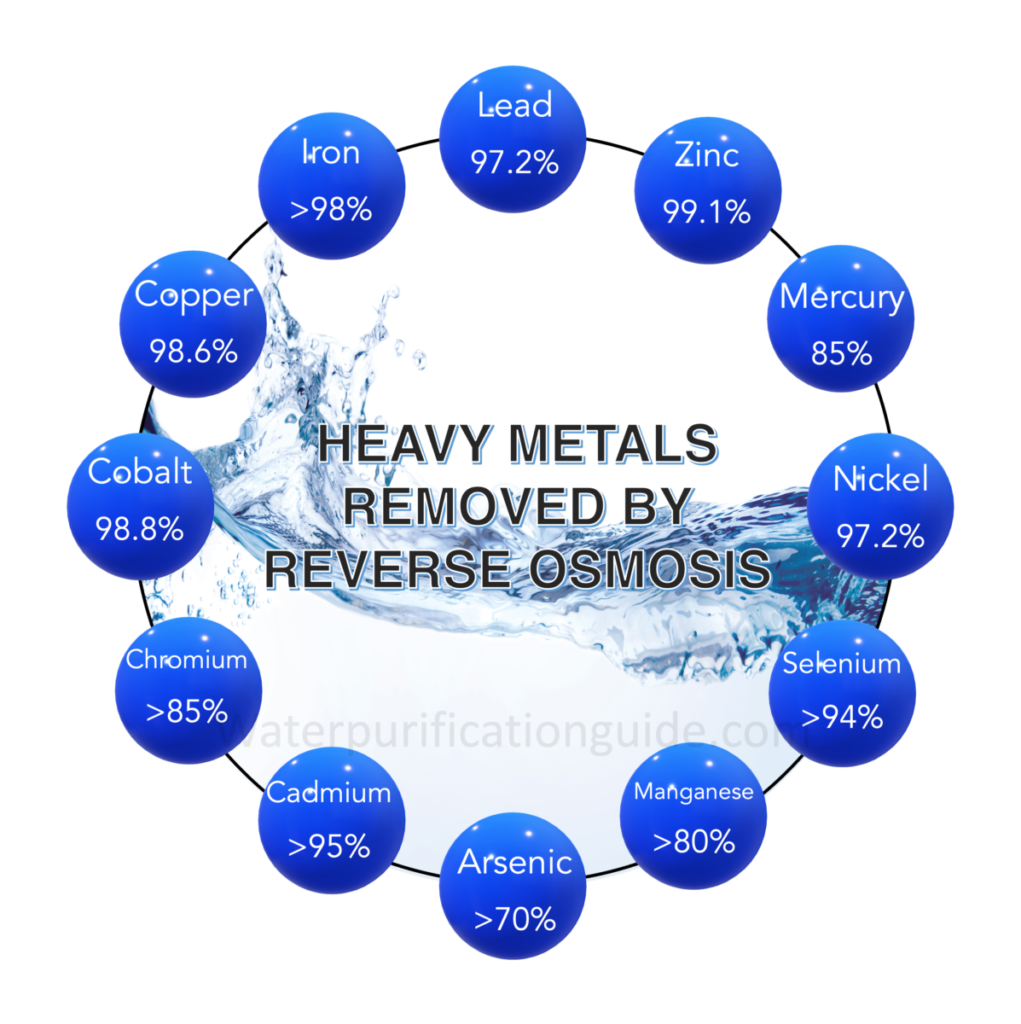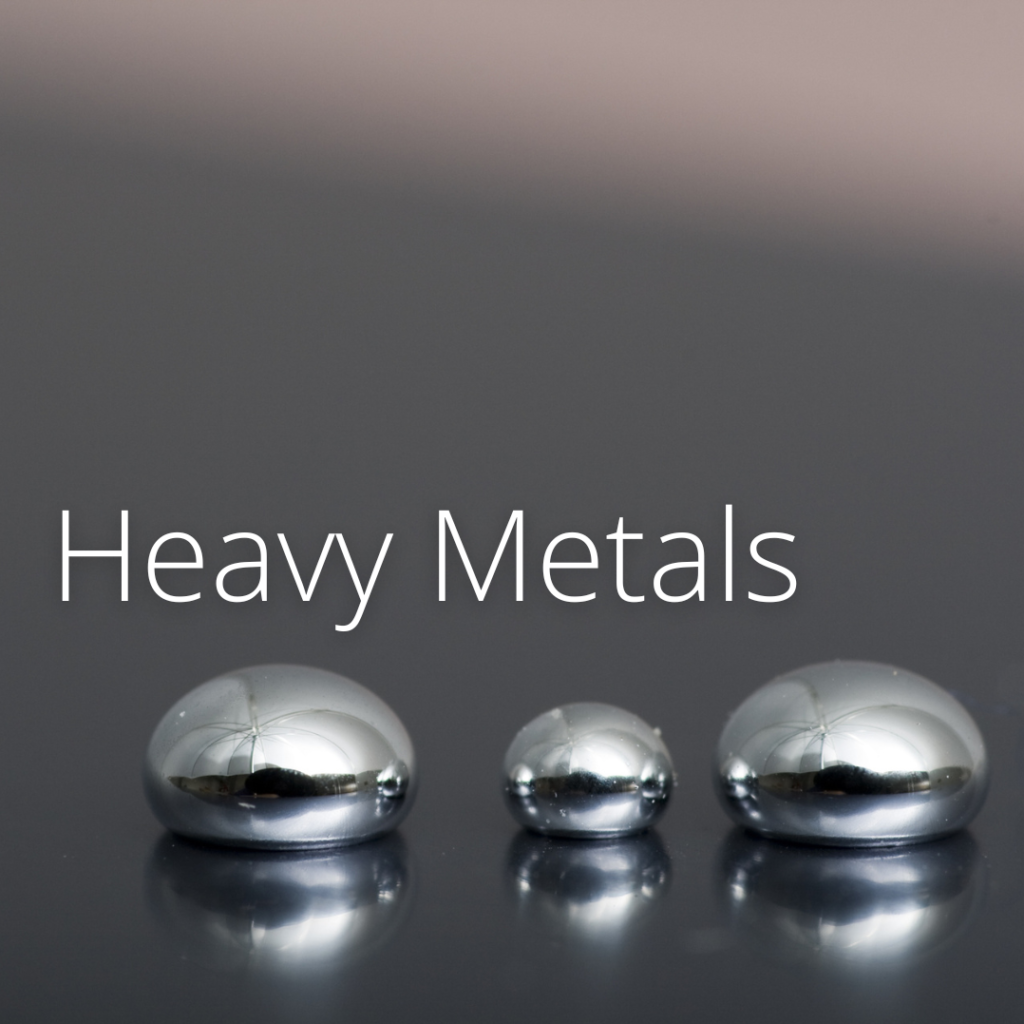Reverse osmosis can remove heavy metals, including arsenic, chromium, iron, lead and mercury. The filtration membranes of reverse osmosis (RO) systems have a pore size of 0.1 nm, several times smaller than heavy metals. Because of this relatively small pore size, RO systems can easily filter out heavy metals.
Reverse osmosis is a water purification mechanism that passes water through a semi-permeable membrane under pressure to remove unwanted substances.
In this article, we will look at what heavy metals are, the variations of RO systems, and how they remove heavy metals. We’ll also introduce you to reliable methods of checking your water for heavy metals.
- Drinking water contaminated with heavy metals can result in heavy metal poisoning or toxicity.
- Most heavy metals can be removed by the membrane in reverse osmosis systems, some metals are also removed by the carbon filter component.
- Reverse osmosis systems used to remove heavy metals from water should have the RO membrane changed frequently.
Heavy metals in water
Heavy metals are a group of metals (or metalloids) that have relatively high densities or atomic weights. Although, the metals classified as ‘heavy’ often vary depending on the context.
Metals referred to as heavy metals in the context of drinking water include:
- Arsenic
- Cadmium
- Chromium
- Cobalt
- Copper
- Iron
- Lead
- Manganese
- Mercury
- Nickel
- Selenium
- Zinc
Some of these heavy metals – like iron, manganese, zinc, copper, and chromium – are good for the body, but in small amounts. When they are in high concentrations, they become detrimental to our health.
While, heavy metals like mercury, lead, arsenic, cadmium, cobalt, nickel, and selenium are dangerous, even in tiny quantities.
How reverse osmosis removes heavy metals
When it comes to removing heavy metals from water, the smaller the pore size of the filter, the better.
Reverse osmosis systems force contaminated water through filtration membranes with tiny pores. The RO filtration membrane pores are so small that it only allows water molecules to pass through.
All other particles bigger than 0.1 of a nanometer are left behind, including lead, mercury, arsenic.

In fact, reverse osmosis can effectively remove many heavy metals in water, including:
- Arsenic (70-99%)
- Cadmium (>95%)
- Chromium (>85%)
- Cobalt (98.8%)
- Copper (98.6%)
- Iron (98-99%)
- Lead (97.2%)
- Manganese (80-100% – depending on membrane material, cellulose acetate has the worst removal rate)
- Mercury (>85%)
- Nickel (97.2%)
- Selenium (>94%)
- Zinc (99.06%)
Most heavy metals are removed by the RO membrane, although a few are also partially removed by the activated carbon pre-filter that many RO systems have.
For example, there are several different forms of chromium. Chromium 6 (Cr VI) can be removed by the RO membrane, while chromium 3 (Cr III) and chromium 6 can be removed by the carbon filter.
Reverse osmosis units are also especially capable of removing arsenic V or pentavalent arsenic, a type of arsenic common in water. However, other forms, especially arsenic III, require a pre-treatment such as potassium permanganate, ferric chloride, or chlorine for a reverse osmosis system to be effective.
When it comes to iron, the RO membrane can effectively remove up to 99% of all the different types of iron in water, including ferrous (soluble), ferric (insoluble) and organic. Some of the ferric iron is also removed by the carbon filter.
While reverse osmosis is a great choice for filtering water in the home, it’s important to note that if your water is high in copper or chromium, these metals will degrade the RO membrane fairly quickly.
This means that the reverse osmosis system is still effective at removing the heavy metals (and other contaminants) from your water, but that you will likely need to replace the RO membrane more frequently than what is recommended by the manufacturer.
Reverse Osmosis Systems That Remove Heavy Metals
While most reverse osmosis systems are able to remove heavy metals with good efficiency, they often don’t provide their reduction data. Here is a breakdown of three great products – APEC (Essence series), Crystal Quest, and Waterdrop (400 GPD, G3 system) – and how well they remove certain heavy metals:
| Heavy metal | APEC | Crystal Quest | Waterdrop |
| Arsenic | 99% | 98% | >90% |
| Cadmium | 98.3% | 87% | >90% |
| Chromium | 98.3% | 93% | >90% |
| Copper | 98.4% | No data | >90% |
| Iron | No data | No data | >90% |
| Lead | 96.8% | 97% | >90% |
| Manganese | No data | No data | >90% |
| Mercury | No data | 99% | >90% |
| Nickel | No data | No data | >90% |
| Selenium | 97.9% | 94% | No data |
| Zinc | No data | No data | >90% |
Does Boiling Water Remove Heavy Metals?
Boiling water does not remove contaminants such as lead, arsenic, and other heavy metals. No amount of boiling can remove these metals. The boiling point of heavy metals is usually higher than that of water, so as the water boils and begins to evaporate (as steam), the heavy metals remain in the water and become increasingly concentrated.
Boiling water is a recommended alternative in situations when your regular water supply has been interrupted. E.g. in emergencies like earthquakes or hurricanes.
Boiling is enough to kill most bacteria, viruses, and other disease-causing organisms.
Usually, it has to be combined with other water purification methods like decantation, filtration, and disinfection with household bleach.
Unfortunately, even combined with these other methods, boiling isn’t sufficient to remove heavy metals, salts, certain chemical contaminants, etc.
In some cases, boiling water that contains heavy metals may cause more harm than good. For instance, some heavy metals release volatile substances when heated.
A good example is mercury. When heated, certain forms of mercury may be released into the air as vapor.
Mercury vapor is more dangerous than liquid mercury at room temperature because it easily passes into the bloodstream through the lungs.
How Do I Know If My Water Has Heavy Metals?
The most reliable way to know for sure if your water has heavy metals is by sending it for a lab test. This is especially important if you have any reason to suspect you may be at risk e.g., living in an old house or relatively close to areas of industrial or mining activity.

The Essential Home Water Test from Tap Score covers a suite of 23 heavy metals and over 20 other water contaminants.
- Order today and they’ll send out the kit and instructions on how to collect the samples.
- Send the sample back to the lab for analysis – shipping is included.
- You’ll get a comprehensive report on what is in your water in about 5 days.
For more information and to order your Essential Home Water Test click here.
Laboratory testing is a worthwhile investment. Though it may be a bit expensive, it’s nothing compared to what the risk of long-term exposure to heavy metals can cost you.
Water aesthetics (taste, smell, and appearance) can also hint at specific heavy metals in water.
For example, manganese can give water a metallic taste and a brownish-red discoloration that can stain laundry and faucets.
Manganese may also give water a foul odor.
Black slime in water, in your toilet bowl, around the holes of your shower faucet, and other plumbing fixtures is also a sign of manganese in your water.
Copper is another heavy metal that can be detected by assessing your water aesthetics.
When present in a significant amount, it gives water a metallic taste and causes blue-green stains on plumbing fixtures.
Many heavy metals like lead, chromium, nickel, etc., are very difficult, or even impossible, to detect without a laboratory test.
Effects of Heavy Metals in Water
Heavy metals are naturally present in the earth’s crust. In fact, some soils are relatively rich in heavy metals. When rain falls on this type of soil, it can break them down and release heavy metals, causing them to seep into rivers, lakes, underground aquifers, etc.
Heavy metals may also enter your water from industrial and consumer waste.
Some industrial activities that give off heavy metals as waste include metal and coal mining, manufacturing of batteries, leather and textile manufacturing, oil and gas refinement, etc.
These waste products can enter underground water through broken or leaking tanks and pipelines, accidental spills, the use of unlined effluent lagoons for the treatment of wastewater, improper or uncontrolled wastewater discharge, etc.
The danger of heavy metals is largely a result of the fact that these metals tend to bioaccumulate.
This means that, when ingested, they are broken down and excreted from the body very slowly.
If exposure continues, because their removal from the body is so slow, they accumulate in organs like the brain, kidney, etc.
Exposure to these heavy metals can result in symptoms of heavy metal poisoning or toxicity. Some of these symptoms include:
- Abdominal pain
- Diarrhea
- Unusual weakness or fatigue
- Nausea
- Vomiting
- Brain damage (could be memory loss, convulsions, etc.)
- Difficulty breathing
- Kidney damage
- Liver damage
- Increased risk of cancer
- Miscarriage in pregnant people
Five heavy metals are of particular concern because they are more frequently the cause of heavy metal poisoning than the others. These five metals are mercury, lead, arsenic, chromium, and cadmium.
